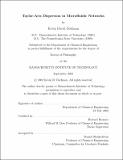Taylor-Aris dispersion in microfluidic networks
Author(s)
Dorfman, Kevin David, 1977-
DownloadFull printable version (813.9Kb)
Other Contributors
Massachusetts Institute of Technology. Dept. of Chemical Engineering.
Advisor
Howard Brenner.
Terms of use
Metadata
Show full item recordAbstract
This thesis constitutes the development and application of a theory for the lumped parameter, convective-diffusive-reactive transport of individual, non-interacting Brownian solute particles ("macromolecules") moving within spatially periodic, solvent-filled networks - the latter representing models of chip-based microfluidic devices, as well as porous media. The use of a lumped parameter transport model and network geometrical description affords the development of a discrete calculation scheme for computing the relevant network-scale (macrotransport) parameters, namely the mean velocity vector U*, dispersivity dyadic D* and, if necessary, the mean volumetric solute depletion rate K*. The ease with which these discrete calculations can be performed for complex networks renders feasible parametric studies of potential microfluidic chip designs, particularly those pertinent to biomolecular separation schemes. To demonstrate the computational and conceptual advantages of this discrete scheme, we consider: (i) a pair of straightforward examples, dispersion analysis of (non-reactive) pressure-driven flow in spatially periodic serpentine microchannels and reactive transport in an elementary geometric model of a porous medium; and (ii) a pair of case studies based upon the microfluidic separation techniques of vector chromatography and entropic trapping. (cont.) The straightforward examples furnish explicit proof that the present theory produces realistic results within the context of a simple computational scheme, at least when compared with the prevailing continuous generalized Taylor-Aris dispersion theory. In the case study on vector chromatography, we identify those factors which break the symmetry of the chip-scale particle mobility tensor, most importantly the hydrodynamic wall effects between the particles and the obstacle surfaces. In the entropic trapping case study, analytical expressions derived for the solute dispersiviy, number of theoretical plates, and separation resolution are shown to furnish results that accord, at least qualitatively, with experimental trends and data reported in the literature.
Description
Thesis (Ph. D.)--Massachusetts Institute of Technology, Dept. of Chemical Engineering, 2002. This electronic version was submitted by the student author. The certified thesis is available in the Institute Archives and Special Collections. Includes bibliographical references (leaves 172-183).
Date issued
2002Department
Massachusetts Institute of Technology. Department of Chemical EngineeringPublisher
Massachusetts Institute of Technology
Keywords
Chemical Engineering.